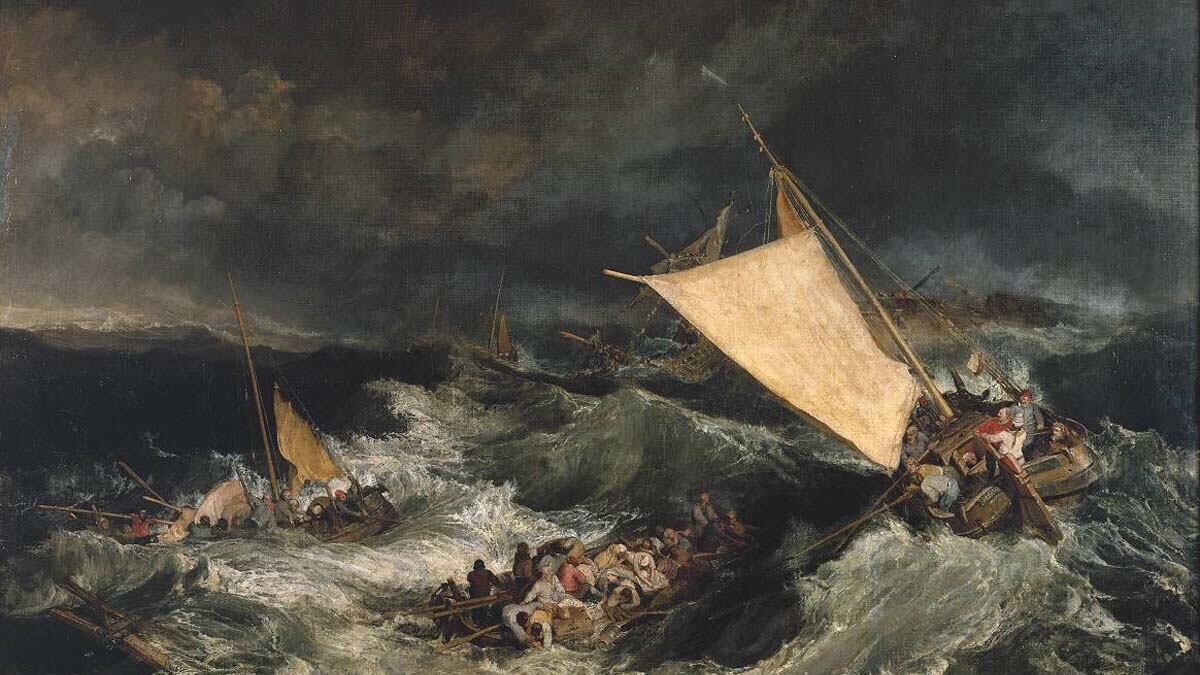On Monday night, as reports came in of Hurricane Sandy's landfall on the Jersey Shore, the one word, and the one emotion, that kept coming up was “awe.” Reporters were in awe of the storm surge, of the winds, of the destruction. Listening to their charged words, you got carried, Miss Clavel-like, to the scene of the disaster. Some of us also got carried back in time by about two centuries, when the idea of standing in awe of nature’s power—the sublime, it was called, “an agreeable kind of horror"—was at the heart of a lot of the best art being made.
"Whatever is fitted in any sort to excite the ideas of pain, and danger, that is to say, whatever is in any sort terrible, or is conversant about terrible objects, or operates in a manner analogous to terror, is a source of the sublime,” wrote Edmund Burke in 1757, turning the idea into a full-blown aesthetic theory.
Ludwig van Beethoven bought into it, in 1808 in the famous storm movement in his Sixth Symphony, but also in all the stormy passages in his other pieces. J.M.W. Turner did, too, in his amazing paintings of tempests at sea from around the same date. (It wasn’t enough for Turner to simulate the sublime in paint; he also needed to experience it directly, by having himself lashed to a ship’s mast during a storm—or at least so he claimed to have done.)
Most other artists in the years to either side of 1800 at least dipped into the terror of nature and the uncontrolled emotions it provoked. (I’m listening to tempestuous bits of Schubert as I write.) The sublime seemed such a natural, necessary part of art making that entire aesthetic systems were built around it, and they’re still central to discussions in philosophy departments.
What’s interesting is that the sublime has almost completely disappeared from the art that’s actually being made today. There are some guitar blasts in heavy metal and hardcore, but they don’t seem tohave much to do with nature, and have less to do with fear: They seem mostly about the power of audio technology to overwhelm our eardrums.
Today’s visual art seems equally sublime-free; our most important artists prefer effects that are relatively small and cerebral and human-scaled. Hollywood movies may be the one area where what youcould call the Imax sublime is in play, although the out-of-control nature we confront in a CGI blockbuster is more likely to be found in outer space than down here on earth.

We 21st-century earthlings have become so distanced from the terrors of nature that most of the time we don’t care enough about them to turn them into art. Even when we head to a high mountaintop, there’s so much reassuring technology built into our trip that we can barely imagine anything going wrong. (Our most terrifying nature moment in recent years may have been that hiker’s encounter with a falling boulder in Utah, and the amputation of his own hand with a pocket-knife which, in cinematic art, got acted out by James Franco as an internal psychological drama, almost kitchen-sink scaled, with nature in the background.)
It takes the complete breakdown of our technological safety nets —seeing cars floating up Wall Street; watching tunnels flood and transformers explode, marveling at SoHo going dark—to shock us back to standing in awe of nature’s grandeur, as our ancestors did. But I doubt our current awe will last very long, as waters recede and power is restored. I can’t imagine much art coming out of it.
It could be that our current distance from nature’s sublimity is actually the end point in a process that launched the sublime in the first place. It was technology, after all, that made it ever easier for the thinkers of the British Enlightenment, living in the mild-mannered south of England, to get access to the terrible beauty of the Alps (or even of their own Lake District). And it could have been their own growing distance from nature’s terrors that made them care so much about them in the first place, for the first time.
As the Industrial Revolution took off, more and more people left the land for the unnatural world of the city. (The percentage of English people living in towns more than doubled between 1700 and 1830.) Artists’ sudden interest in untamed nature may have been as much about filling a new absence in the collective unconscious as about responding to anything most people felt in their daily lives.
When nature is truly a threat, on a day-to-day basis, you try to keep it out of mind and out of doors; you make gardens and pictures that tame it. It’s only when its threat starts receding that you invite nature inside again, in art, to get some of the frisson that you find you’ve been missing. At a certain point, however, nature becomes so distanced from our technologized lives that it barely features at all in our psyche.
Of course, there’s nothing good about the harm that Sandy wrought, and global warming’s a distinctly bad thing. But it could be that, in a small way at least, Sandy will wake us up to how little power we actually have against the full unleashed force of nature. And make us realize that we don’t want to give nature more leash than we already have. Maybe we will need some new art to remind us of that, after all.






